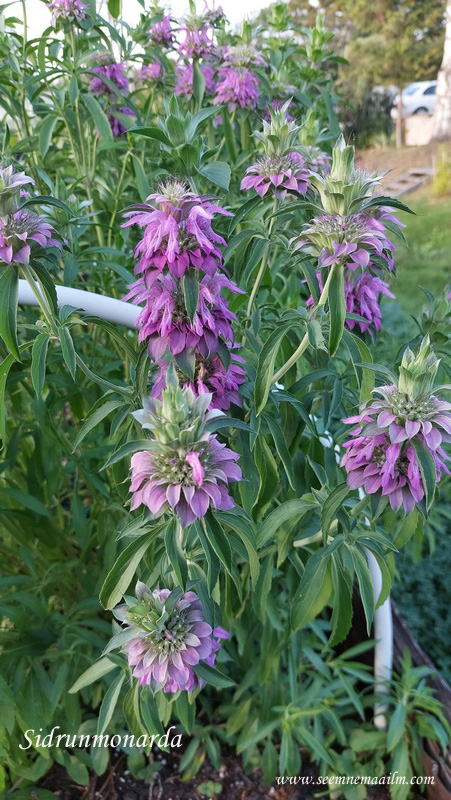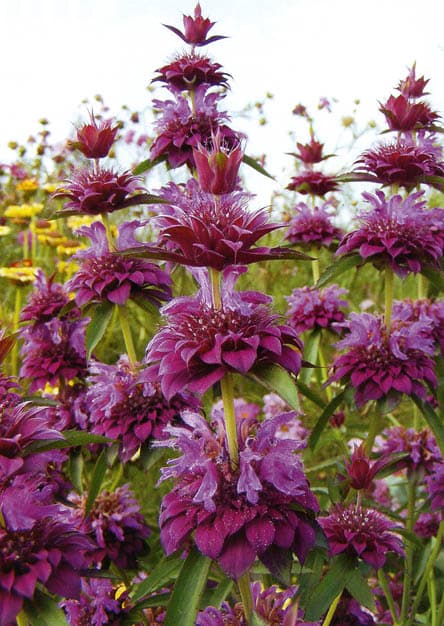Perennial plant up to 80 cm high- a honey plant with shoots exuding a wonderful aroma and unusual pink-purple flowers, attracts bees and butterflies to the garden. The bright flowers of lemon monarda are attractive not only in color, but also in their unusual shape. They form two or three, and sometimes more, flower "floors" at the ends of the stems, growing one from the other. This species is especially interesting for growing on personal plots, since it can be used not only as an ornamental, but also as a gingerbread and medicinal plant.
All parts of the plant have a strong, pleasant, slightly spicy aroma. The leaves, stems and flowers contain essential oil, which has the same components as basil, mint, lemon balm and has antimicrobial and antiseptic properties.
Monarda is widely used as an additive to tea - just a couple of leaves will give a cup of tea an exquisite aftertaste, a seasoning for meat dishes and salads to whet appetite and improve digestion.

Cultivation.
The plant is undemanding, cold-resistant, and prefers light neutral soils (does not tolerate acidic and very wet peat soils).
It responds well to the application of organic fertilizers.
Monarda is light-loving but also tolerates partial shade. Seeds are sown for seedlings in March-April, seeding depth 0.5-1 cm. Pricking out in the phase of 1-2 true leaves at a distance of 3-4 cm from each other. Planting in the ground in a permanent place in late May – early June.
It can be grown without seedlings. Sowing in open ground in May with subsequent pricking out and transplanting to a permanent place. Planting pattern 40x50 cm.
Care involves weeding, fertilizing, and watering as needed.
For harvesting, plants are cut during mass flowering at a height of 20-25 cm from the soil surface.
Monarda does not lose its scent when dried; the dry raw material retains its aroma for up to 2-3 years (it is better to store it whole, not crushed).

Bergamot, Scarlet Monarda, Oswego Tea or Crimson Beebalm.
* Monardas – charming plants with red, pink, or lilac flowers. Their entire appearance suggests a cozy, slightly neglected garden where one can get lost on a hot day, admiring the tufted inflorescences to which buzzing bees and carefree butterflies flock. Plant monardas along a path, and they will delight you not only with their appearance but also with their wonderful aroma every time you brush against their foliage while passing by.
Despite the fact that monarda was brought to Europe back in Columbus's time, it became widely cultivated only in the 18th century, approximately the same period when Linnaeus's works appeared.
Since then, thanks to their decorative qualities and high content of essential oils in the leaves and flowers, monardas have enjoyed great success among gardeners and pharmacologists.
In addition to its high decorative value, monarda also possesses other, no less valuable qualities. No wonder it has such folk names as "bee balm", "mountain balm", "lemon mint", "American melissa", and "wild bergamot". Indeed, in terms of essential oil composition, Monarda didyma is close to the famous Italian citrus plant—bergamot, a relative of lemon and orange, which is used to flavor the famous "Earl Grey" tea. A similar aroma can be obtained by adding monarda flowers to tea.
The medicinal properties of monarda were well known to the Native Americans of North America. The plant was used as an antiseptic, a sedative, a diaphoretic, and to improve the digestive system. They also used it as tea. Hence, according to another version, comes the name "Oswego tea", after the Native American tribes who lived in that area (around the Great Lakes) and taught the first colonists to use this drink.
Hybrid monardas, because one of the parent species, Monarda didyma, grows in moist places in natural conditions, although they prefer well-drained soils, can be used in mixborders in waterlogged areas and planted together with species such as loosestrife, lysimachia, meadowsweet, and aruncus.
Monardas, also thanks to their fragrant foliage and flowers, can take their place next to lemon balm, oregano, basil, mint, and other plants in an apothecary garden or a butterfly garden. Such gardens, specially created to attract butterflies and birds, are very popular in Europe, America, and Australia, and monarda is one of the favorite plants in them.
Monarda is undemanding to soil, but it is better to avoid highly acidic and waterlogged areas. It grows well both in sun and partial shade. It spreads quickly and is best divided in spring and autumn by sections of rhizomes with buds. Additionally, monarda is propagated by cuttings.












